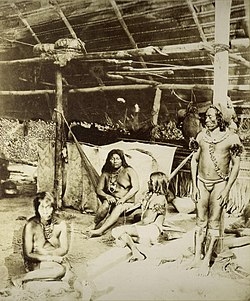Tikuna people

Ticuna people in Amazonas, Brazil, ca. 1865
|
|
| Regions with significant populations | |
|---|---|
|
( |
36,377 (2009) |
|
|
8,000 (2011) |
|
|
6,982 (2007) |
| Languages | |
| Ticuna | |
| Religion | |
| Shamanism, Christianity | |
The Ticuna (also Magüta, Tucuna, Tikuna, or Tukuna) are an indigenous people of Brazil, Colombia, and Peru. They are the most numerous tribe in the Brazilian Amazon.
The Ticuna were originally a tribe that lived far away from the rivers and whose expansion was kept in check by neighboring peoples. Because of their historical lack of access to waterways and their practice of endogamy has led to the Ticuna being culturally and genetically distinct from other Amazonian tribes. The first contact with outsiders occurred on 22 April 1500 when a Portuguese fleet exploring the Amazon came into contact with the Ticuna. Sustained contact with the Portuguese and other outsiders begain in in 1649. Since the Ticuna lived relatively inland compared to other tribes they were less affected by the diseases and violence caused by colonialism, hence why the Ticuna today have the largest population of any Amazonian peoples. However the Ticuna still suffered greatly, especially in the rubber cultivation that began in the late 19th century where many Ticuna were used for slave labor.
Ticuna as a Brazilian tribe has faced violence from loggers, fishermen, and rubber-tappers entering their lands around the Solimões River. Four Ticuna people were murdered, 19 were wounded, and ten had disappeared in the 1988 Helmet Massacre. By the 1990s, Brazil formally recognized the Ticunas' right to their lands.
Ticuna people speak the Ticuna language, which is usually identified as a language isolate, although it might possibly be related to the extinct Yuri language thus forming the hypothetical Ticuna–Yuri grouping. The Ticuna language was once thought to be an Arawakan language, but his has now been discredited as more likely the Ticuna have adopted many linguistic features due to long history of interaction with Arawakan-speaking tribes. It is written in the Latin script.
...
Wikipedia
